 |
| Lesser Treefrog (Dendropsophus minutus) |
It hasn't been so much writer's block that has kept me from posting about my favorite feature from my stay in Ecuador, I just haven't been able to decide where to begin. Ordinarily, I’ll drive for hours and make dozens of trips in search of new (to me) species. In my home state of Ohio, there are only 80 species of native reptiles and amphibians. Each new find feels that much closer to seeing them all (a dream I’ve had ever since I was young). Finding all eighty might still seem like a lot of time and effort—and it is—but it’s a challenge that’s just on the periphery of reasonable. With enough dedication, I can add a new species every few months (if I’m really lucky, multiple in a single trip!). In the tropics, this ratio is blown way out of proportion. Ecuador is home to 350 species of reptiles and 460 species of amphibians. During a week long stay, you might see 80 or more species without much effort. Add in a guide that knows what they’re doing, and your species list could easily reach the hundreds.
So what’s the problem? With so many species to see, the tropics can feel inaccessible to the average naturalist. Don’t think I’m complaining, though. As a wanna-be biologist, I value biodiversity over my own two legs. Ecuador covers only 109,483 square miles (for comparison, the US covers 3.797 million square miles). It’s remarkable that there are still places on earth that boast such a unique variety of species in such a small area.
 |
| Marbled Treefrog (Dendropsophus marmoratus) |
But how are you supposed to build a reasonable biological picture of such a diverse area in a limited amount of time? Even with the most recent field guides, there is always the chance of stumbling upon something no one has ever seen before (it is estimated that nearly 200 species of frogs have yet to be discovered in Ecuador). More likely, however, is the chance of stumbling upon something no one has ever bothered to put in a field guide. In the end, you might not know what you have. Cryptic species complicate things further. Two or more frog species may look indistinguishable unless you directly observe their calls (or sequence their DNA).
 |
| Dwarf Clown Treefrog (Dendropsophus bifurcus) |
When a night hike down a forested road turns up something new every five minutes, it's impractical to spend an extended amount of time observing any one animal. While I want to see as many herps, birds, and what-have-yous as I can, I’m no life lister. I don’t just want to check off each species and move on to the next challenge. I want to see each creature intimately to try to understand it better.
As I have discovered more and more of Ohio’s reptiles and amphibians, I’ve had to relearn just about everything I thought I knew about the herps of my home state. Each discovery has allowed me to weigh everything I’ve read or assumed about a species against what I have directly observed in nature. It’s all about subverting my expectations. With so many tropical species, I never really know what my expectations should be in the first place. Each find is exciting, but also a little jarring, “Oh! Didn’t realize you existed!”
As I have discovered more and more of Ohio’s reptiles and amphibians, I’ve had to relearn just about everything I thought I knew about the herps of my home state. Each discovery has allowed me to weigh everything I’ve read or assumed about a species against what I have directly observed in nature. It’s all about subverting my expectations. With so many tropical species, I never really know what my expectations should be in the first place. Each find is exciting, but also a little jarring, “Oh! Didn’t realize you existed!”
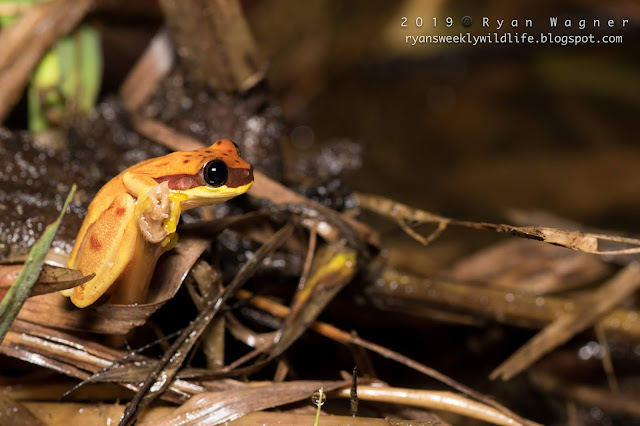 |
| Red-skirted Treefrog (Dendropsophus rhodopeplus) |
To avoid this problem of “overabundance of species,” I have tried to place my discoveries into categories, namely Family or Genus. This gives a wider context that (for me) makes tackling the superabundance of Ecuadorian frogs and toads a little more manageable. I have done my best to ID each of the species I photographed, but many are still up for debate. I am no expert and any suggestions are greatly appreciated.
 |
Crested forest toad (Bufo margaritifer)
|
I will begin with the family Bufonidae. I was on such a high that first night at the research station that you might have assumed I was running around licking toads instead of photographing them. It was thrilling to watch my fellow biology students join in with equal levels of enthusiasm, referring amusingly to our group herping as “The Hunt.”
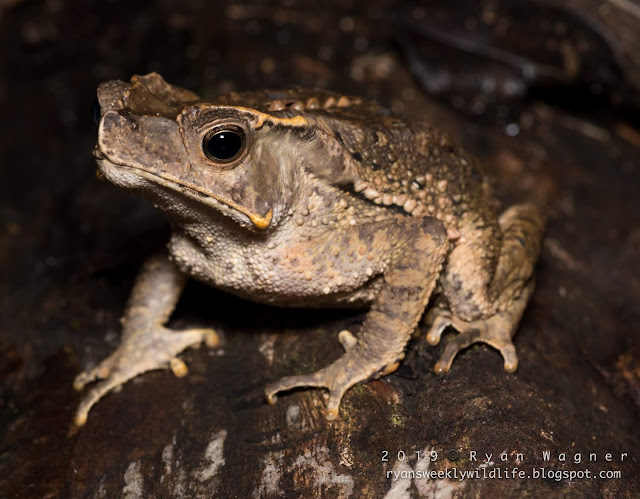 |
| Crested forest toad (Bufo margaritifer) |
The Bufonids are the true toads, locally represented in Ohio by the ubiquitous American toad (Anaxyrus americanus). Tropical bufonids share the warty skin and earth tones, but many species are much more regal in their head adornments. The Crested Forest Toad (Bufo margaritifer) is commonly encountered hopping across the forested trails. These toads are extremely variable; some express slight ridges along their craniums, while others show exuberant crests extending above their eyes and nostrils.
The toads don’t just get fancy in the tropics, they get big too. The Marine or Cane toad (Rhinella marina) can grow over eight inches in length and weigh nearly four pounds. We discovered one of these behemoths the very first night, hopping confidently across the pavement beneath our dorms. They have been introduced to many parts of the world and are driving native amphibian populations extinct by outcompeting and eating local frogs. It was refreshing to see them in their natural habitat where they belong.
The toads don’t just get fancy in the tropics, they get big too. The Marine or Cane toad (Rhinella marina) can grow over eight inches in length and weigh nearly four pounds. We discovered one of these behemoths the very first night, hopping confidently across the pavement beneath our dorms. They have been introduced to many parts of the world and are driving native amphibian populations extinct by outcompeting and eating local frogs. It was refreshing to see them in their natural habitat where they belong.
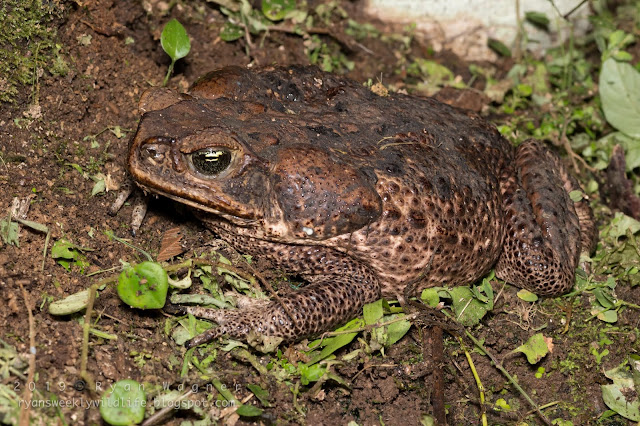 |
| Marine Toad (Rhinella marina) |
Then, of course, there are the treefrogs. Treefrogs belong to the family Hylidae, the largest group of Amazon frogs. Most of these frogs are distinguished by their enlarged toepads which allow them to scale foliage and buildings with ease. Their shear diversity makes them challenging to identify. This is complicated further by the fact that many species change color pattern from day to night.
Three hundred species represent the genus Hyla worldwide (of which, the gray treefrog of Ohio (Hyla versicolor) is a member). Most species in this genus are arboreal, nocturnal, and posses webbed feet. In 2005, many common Amazon treefrog species were split off from Hyla and placed in their own genus Dendropsophus based on their number of chromosomes (many of these species are pictured in the intro to this post).
Three hundred species represent the genus Hyla worldwide (of which, the gray treefrog of Ohio (Hyla versicolor) is a member). Most species in this genus are arboreal, nocturnal, and posses webbed feet. In 2005, many common Amazon treefrog species were split off from Hyla and placed in their own genus Dendropsophus based on their number of chromosomes (many of these species are pictured in the intro to this post).
 |
Giant Broad-headed Treefrog (Osteocephalus taurinus)
|
There is the bizarre treefrog genus Osteocephalus: the Bromeliad or Broad-headed Treefrogs. The skin on the head of these frogs is actually fuzed to the roof of the skull, giving them a distinct, flat-headed appearance. They are a wary group, leaping away from the slightest disturbance. They breed in the shallow pools that collect in the flower cup of bromeliads. The radiated irises of the Giant Broad-headed Treefrog (Osteocephalus taurinus) are mesmerizing.
 |
| White-lined Leaf Frog (Phyllomedusa vaillantii) |
My favorite treefrogs belong to the genus Phyllomedusa: the Monkey frogs. Elongate limbs that bend at sharp angles and opposable thumbs allow these frogs to spread waxy secretions across every inch of their bodies. These secretions act as a kind of sunscreen, helping to prevent desiccation. Their movements are slow and methodical, very unlike many of the other rapid, nervous frog species. The eery stillness of these frogs is almost ghostly when illuminated in the light of a headlamp.
 |
| Veined Treefrog (Trachycephalus typhonius) |
While photographing one particularly bizarre species of Caque-headed Treefrog in the genus Trachycephalus, the veined treefrog (Trachycephalus typhonius), I noticed something sitting along the branch a mere inch from the frog's enlarged toepads. Shining the branch with my flashlight, I was baffled to find a salamander. Amazon climbing salamanders (Bolitoglossa altamazonica) belong to the family Plethodontidae (many of our North American species belong to this family too). Unlike North American species, on humid nights, these salamanders scale vegetation up to six feet high. They sit motionless, apparently doing nothing for hours before returning to the leaf litter by morning.
 |
Amazon climbing salamander (Bolitoglossa altamazonica)
|
The family Leptodactylidea was a mixed bag. A few species, like the enormous Smoky Jungle Frog, struck me as very familiar. It could practically have been a leaf-colored bullfrog. Later, I was shocked to learn it is one of the more toxic species in its range. These jungle frogs belong to Leptodactylus, a genus containing around 55 species, most of which are moderate to large frogs. Some species are so toxic that just holding them can cause a burning sensation on the skin (which was duly noted when I caught a large Smoky Jungle Frog the first night).
 |
| Smoky Jungle Frog (Leptodactylus pentadactylus) |
Other frogs in this family, such as the Painted Forest Toadlet (Physalaemus petersi) were like nothing I had ever seen. These toadlets were speckled with little red lesions that almost made them look diseased. Otherwise, they were cute, little frogs that held their heads erect, giving the impression of an opposable neck.
 |
Painted forest toadlet (Physalaemus petersi)
|
Another member of Leptodactylidae and the only member of its genus, the Painted Antnest frog (Lithodytes lineatus), is a poison-arrow frog mimic. Their pattern of brown with light yellow stripes is almost identical to Allobates femoralis. This is a case of Mullerian mimicry. Both species have converged on a similar coloration because it turns out the Painted Ant-nest frog is also toxic. They live in the mounds of leaf-cutter ants, fending off attack with noxious skin secretions.
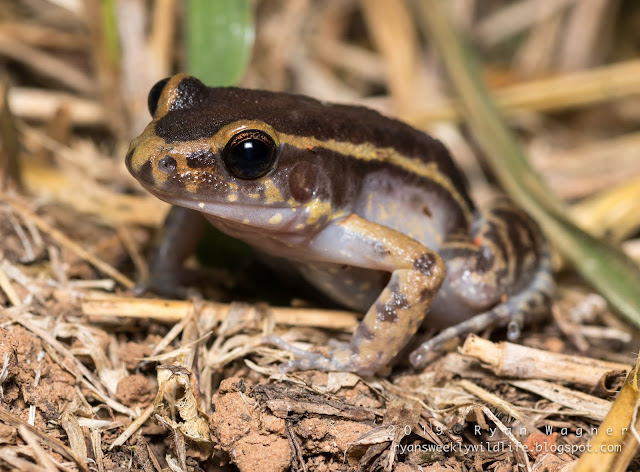 |
Painted Antnest frog (Lithodytes lineatus)
|
The Microhylids, or narrow-mouthed toads are represented in the tropics by a handful of species. Here they are commonly referred to as "sheep frogs." These small frogs grow scarcely longer than an inch.
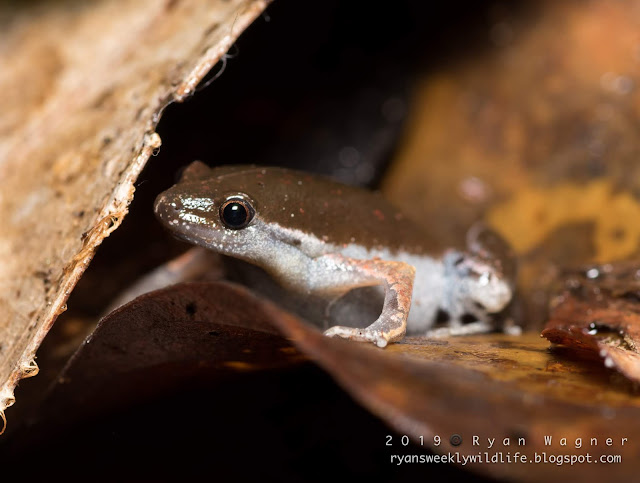 |
| Sheep Frog Species (Elachistocleis sp.) |
If you’re a herper, you might be wondering, “did he see any dendrobatids?” Dendrobatidae is the family that includes the poison-arrow frogs. The short answer is yes. For a while, however, I thought I was going to have to pretend I hadn’t to save face as a photographer.
I actually saw three poison arrow frogs. All were the same species: the Ecuadorian Poison Frog (Ameerega billinguis). These frogs are tiny. The tropics are home to a lot of tiny frogs, but these frogs are really tiny. I mean fit-on-your-fingernail tiny. To escape, all these frogs have to do is hop once. Their red back and yellow-spotted legs allow them to instantaneously disappear among the decaying red and yellow leaf litter. I could be staring directly at the frog, ready to snap a photograph, and a single spring would mean I had to find it all over again. This was the one frog family I felt I needed to photograph (I was even presenting a talk for the class on their family) but for most of the trip, it looked like I was going home empty handed. It wasn't until our group teamed up with the local Wairani guides that my moment finally came.
 |
| Ecuadorian Poison Frog (Ameerega billinguis) |
Nange (pronounced Nahn-gey), the village chief, spotted the frog. He spoke no English, and I no spanish (or Wairani for that matter) but he knew I wanted to see the frogs. He beckoned for me to come over and pointed out the minute frog sitting innocently among the leaf litter, its throat fanning rapidly. We positioned ourselves to make the capture. The frog hopped and was instantly gone. I groaned, certain the little amphibian would not reappear. A moment later, the frog hopped back into view and I was able to grab it (and a decent amount of the surrounding leaf litter) and hand it to Nange.
 |
Ecuadorian Poison Frog (Ameerega billinguis)
|
Nange placed the frog in the middle of the trail for me to photograph. I got some delightful shots, emphasizing the little amphibians gorgeous color pattern and texture. When I returned home after our two weeks, I immediately downloaded my 5,000+ photos. I had taken so many images that my computer’s hard drive filled up. To make room as quickly as I could, I deleted the photos I had already imported from my chip. Once that was finished I started scrolling back through the two weeks and that’s when DISASTER struck. My computer had glitched when the hard drive had filled up, and the images of my poison arrow frog (and only my poison arrow frog) had been deleted.
I was horrified to say the least. Months passed and I couldn't bring myself to write anything about the amphibians without my crown jewel. “You’ll just have to go back one day and photograph another,” I tried to tell myself. Inexplicably, when going back through my photos last week—wallah! Unharmed on the screen in front of me: my poison arrow frogs. I don’t know what cosmic force took pity on me, but I’ve never been so relieved.
Even though my poison frog photos turned up, I am still certain I need to return to Ecuador and the Amazon Rainforest. There are so many more frogs to see after all.
Even though my poison frog photos turned up, I am still certain I need to return to Ecuador and the Amazon Rainforest. There are so many more frogs to see after all.





You literally never say the least.
ReplyDelete